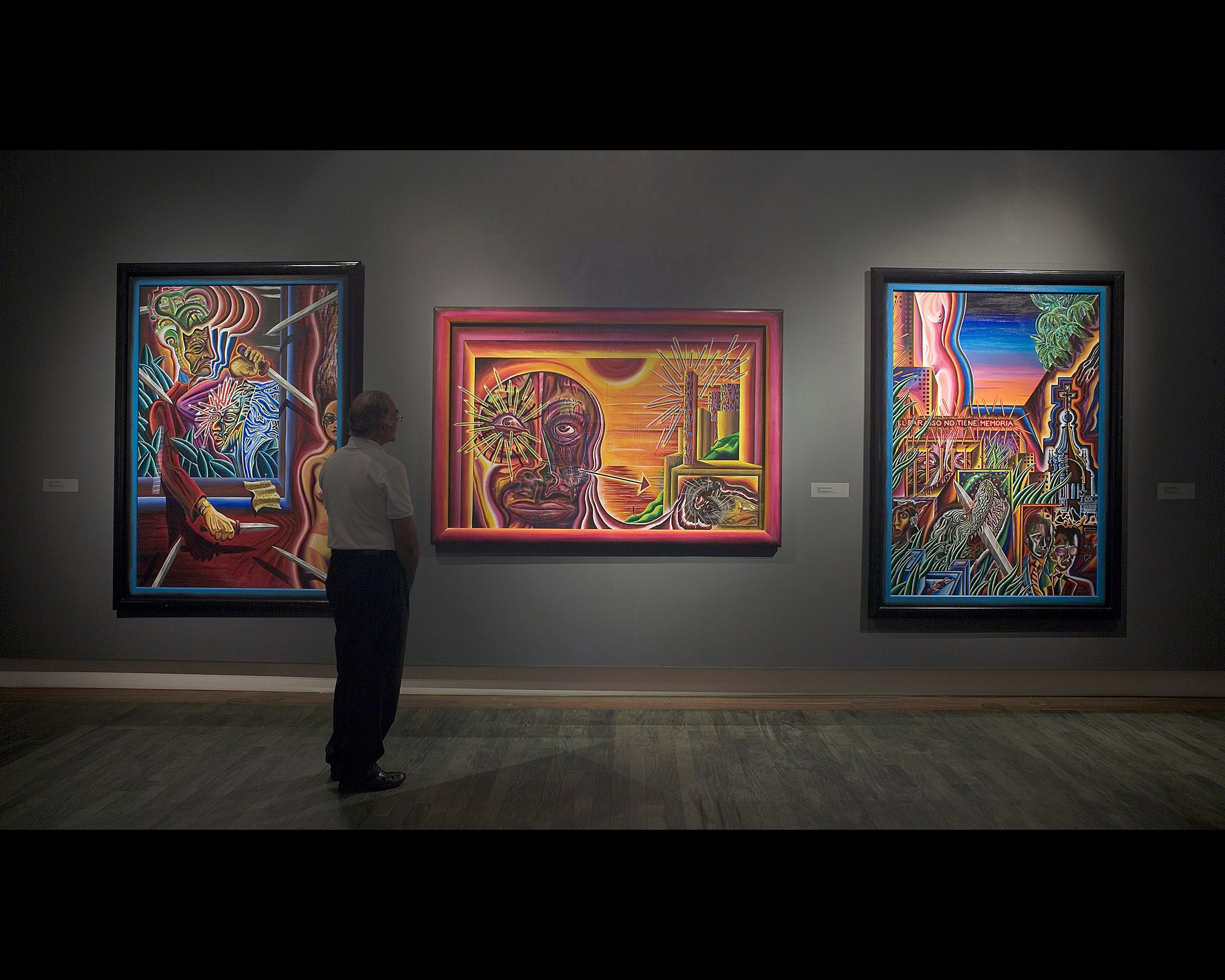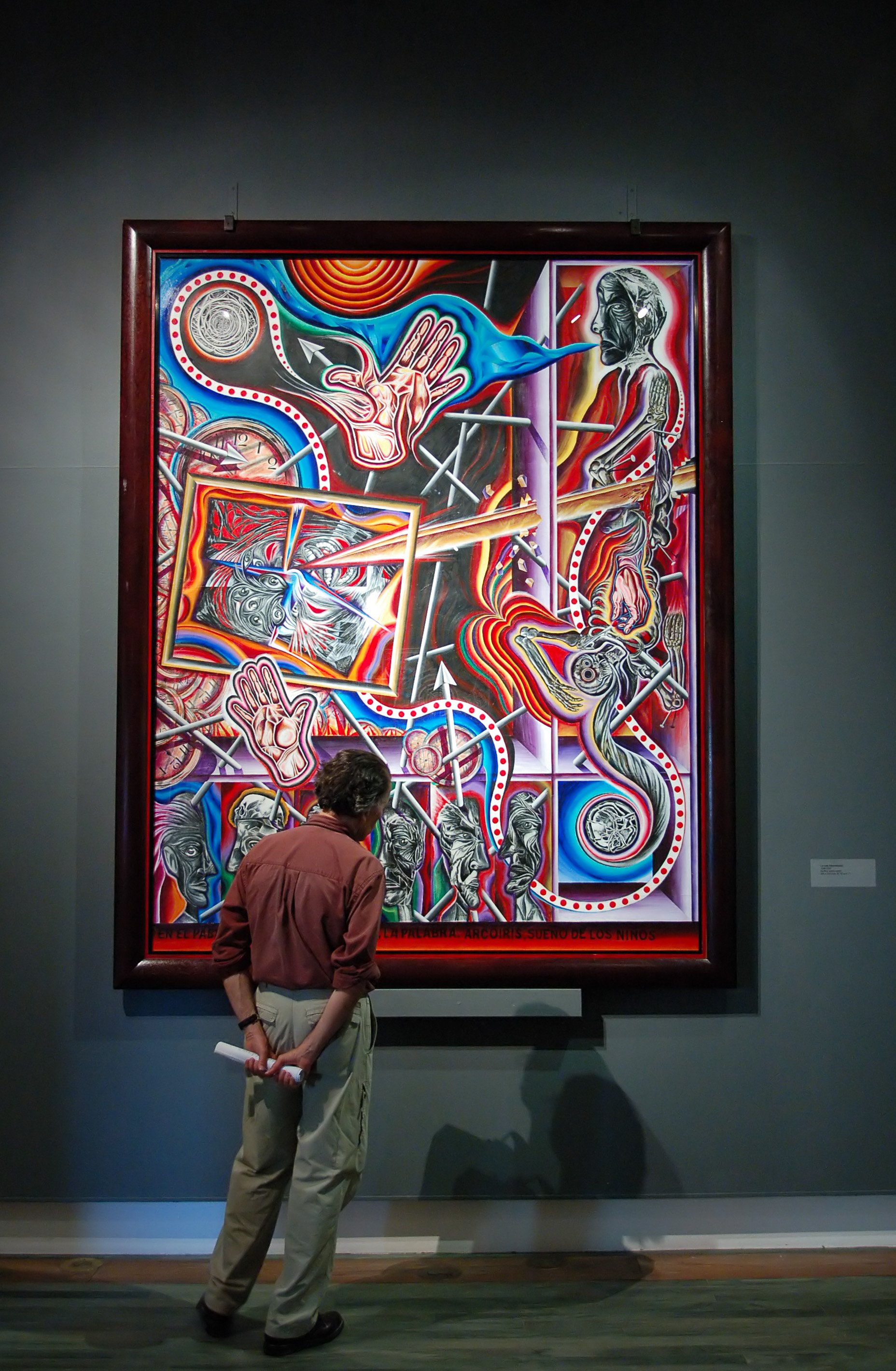CORNERSTONE: RAFAEL 'CHAFO' VILLAMIL
“Rafael ‘Chafo’ Villamil is arguably the most important living Puerto Rican artist today that you never heard of.”
Villamil should be mentioned in the same conversation as notable Puerto Rican artists Francisco Oller, Rafael Tufino, Jose Campeche, Antonio Martorell, Miguel Pou, Arnaldo Roche-Rabell, Myra Baez, Wichie Torres, Lorenzo Homar, Ramon Frade, Julio Rosado del Valle, Epifanio Irizarry, Rafael Ferrer, and Papo Colo. Villamil to date remains unknown and under the radar of curators, academics, gallerists, critics and the gatekeepers of today’s art world. In my opinion Villamil’s decades long visual artist anonymity was primarily his own device.
Villamil’s occupation is that of a noted and successful architect who amongst his many accomplishments worked with famed architects Louis Kahn and Henry Klumb. Villamil’s extensive architectural work meant he never had to rely solely on his art career to sustain his livelihood. He could focus on his artistic process and practice, not connections and sales. I believe his artwork and visibility suffered from the lack of exposure, art history, and context.
Villamil’s lifework is impressive in scope, scale and output. He has been a productive working artist from 1954 to present and has never put his brush down so to speak. I attribute his outsider artist status to the insular World Mr. Villamil inhabits. His personal philosophy and belief is that the job of the critic, and gallerists, is to make the lifework of a mature, unknown, and under-represented artist known to collectors, and museum directors.
Villamil is in possession of masterpieces in his canon which is relatively unheard of in today’s marketplace. The exception being blue chip artists with proven market value. We rarely talk about a singular work of art but we commonly speak of the artist as if he or she is the masterpiece and the artwork a byproduct.
The Art World is and continues to be in a constant state of redefining itself in regards to what artists are exhibited, considered important, and collected. It would be unconscionable and unforgivable if Villamil contributions to the landscape of modern and contemporary art are ignored. I say better late than never and now that the artist, in his eighties, is attempting to start a discourse with the art world and especially the Latinx community, the time is now.
I had the pleasure and fortune of meeting and walking through Mr. Villamil’s exhibition: ‘Paradise Has No Memory’ at the Taller Puertorriqueño in Philadelphia, Pennsylvania with the artist present.
I was invited to have lunch at his home followed by a studio visit and here’s talk below that followed between me and the Master.
Terrence Sanders-Smith – Your work is extraordinary and monumental. Each piece is rich in symbolism, hidden meanings and aesthetic beauty and a World within itself. What inspires you to create a new work? How do you compile the source materials? Is it conceptual or instinctual?
Rafael ‘Chafo’ Villamil - I never start a piece knowing exactly what the end result will be. I usually start with something small that I'm curious about, a hand, a building, something that won't even end up being central to what the painting will become. It will lead to something else and then to something else until a story starts to reveal itself. Then I start to obsess about the story, its characters, what I want to say about them and what they want to be said about themselves. The point being the process is a journey and a sacred one. I am done when I have realized the destination.
TSS – Arguably, I view many influences in your work: Mainly Surrealism, Expressionism, Symbolism, and Modernism. What artists and or art movements would you say had the greatest impact on your practice?
RCV – I was interested in drawing and painting when I was in grade school mostly because it got me out of gym class. I attended a Catholic school. So, my first influences came from copying Nativity scenes and doing banners for events. I can't say I subscribe to any "Ism" but there are many artists I like ( Picasso, Matisse, Henry Moore, Lucien Freud, Francis Bacon, Dali's first show, etc. )
TSS – You’ve been creating art religiously for over 65 years. In 65 years, you had very few exhibitions. Why haven’t you exhibited your work to reach a larger audience?
RCV – The short answer is I blame the system. In the 60s, my work showed at what was considered at the time to be the best possible venues for a Puerto Rican artist who didn't paint Landscapes with Native People plowing the ground with the weight of the world on their shoulders. The criticism I got was generally very positive or, they considered me too confrontational. I like to think of my work as both.
TSS – Everyone believes their work is necessary, relevant and important. That their respective voice is the voice of their generation. Do you consider your voice and your work to be paramount in those principle beliefs?
RCV – It's always relevant.
TSS – Based on our correspondences I know you want your work to find a larger audience. Do you want recognition for your contributions? Why now? Why after so much time has passed do you feel a sense of urgency?
RCV – Though I am 89 years old, I have always sought recognition. But, it has always been a battle with the gatekeepers who have become more myopic and obsessed with easy profit over any artistic merit.
TSS – Are you disappointed that at this point in your career you’re still basically unknown? Do you feel you have been disrespected and or belittled in any respect by curators, critics, gallerists, and or museum directors?
RCV – Yes, I am disappointed but, not personally.
TSS – What is your interpretation of the current climate of the art world? How is it different from let’s say the 50’s, 60’s, 70’s, 80’s or 90’s?
RCV – At some point it started growing into a for profit business more concerned with crafting an investment and becoming disinterested in what is Art. Art used to be sacred. Somehow, the modern world has sought to distance itself from it.
TSS – Do you want to be known as an artist or a Latinx artist? Do you feel Latinx artists and their contributions are valued and or validated by the establishment or is it old business as usual in meeting minority quotas?
RCV – Though I don't really follow the "Business" of Art, I have no doubt of its cynicism. The idea of "Quotas" seems all too believable. I don't know if I exactly understand what is ‘Latinx’. However, I am an Artist, I am Puerto Rican. So, it is fair to say I am an Artist who is Puerto Rican.
I think being labeled a ‘Puerto-Rican’ artist is reductive and negates who I am and what I do for the sake of quantifying me into some impersonal catalog of numbers. I am also an Architect, a Poet, an Historian and much more. With each of these "Identifiers" that calculus becomes more ridiculous. Sadly, it is too easy to do but in the end, it's inherently, false.
Words are very important in my work. I originally did paintings in English. A few years later I didn't want to do that anymore. So, I came back to myself and I was more myself in Spanish.
Later, I came to realize that even my "English" paintings were inescapably Spanish.
TSS – I’ve seen a lot of artists come and go over the decades. Mostly riding the tide of trends, gimmicks, and or nepotism. Basically, they didn’t have a body of work that stood the test of time. You on the other hand don’t share any of the characteristics of these speculation art stars. What is your advice to the galleries, critics, collectors and museum directors that support and nurture the status quo.
RCV – My advice would be develop a passion for Art. Make that and the question of what it is, sacred to what you do. Profit should be a distant second.
TSS – It's a popular belief that the artist is only one set of eyes away from recognition. I’m skeptical of that theory because in order to separate yourself from the herd you must have a track record, a collector base and an IG following. The current trend in the art world is payback time for mature and under-represented African American artists. Every notable African American artist who was neglected by the white male dominated art world is being recognized and becoming rich in the process. What about Latinx artists? Do you feel you and your community have been fairly represented over the decades? Do you see Latinx artists being the next in line to receive recognition and reparations?
RCV – I haven't seen it yet...
TSS – If you could go back to 1954, knowing what you know now, what, if anything, would you do differently in regards to your art practice?
RCV – I would try much harder to get shown.
TSS – Thank you for taking the time to speak with me.
RCV – Thank you.
Installation Shots: ‘Paradise Has No Memory’ at the Taller Puertorriqueño in Philadelphia, Pennsylvania.













